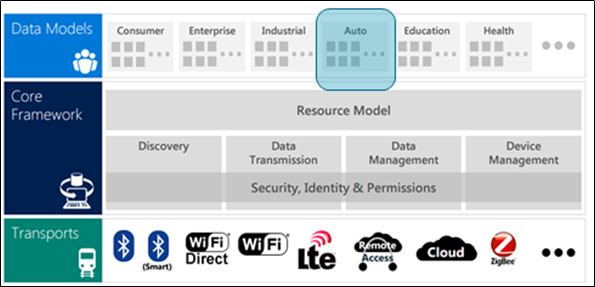...
c. A vendor neutral certification program: OCF certificationIoTivity
6.6.2 IoTivity
The IoTivity project was created to bring together the open source community to accelerate the development of the framework and services required to connect these billions of devices. The IoTivity project is sponsored by the Open Connectivity Foundation (OCF), a group of industry leaders who will be developing a standard specification and certification program to address these challenges. IoTivity will deliver an open source reference implementation of the OCF standard specifications, yet will not be limited to those requirements. IoTivity is licensed under Apache 2.0 and follows a well-defined open source development model and release cycle.
IoTivity has already been ported to a multitude of OS platforms including Linux (ex. Ubuntu), Android and Tizen and it has been verified on multiple developer reference hardware devices like Arduino, Raspberry Pi, smartphones (Android and Tizen), wearable devices (like Gear S2). IoTivity supports multiple programming languages like Java, C/C++, Javascript (nodejs) etc. For resource constrained devices running on low power MCUs, IoTivity has an alternative implementation of the core OCF specifications known as “iotivity-constrained”.
IoTivity Architecture
The IoTivity architecture can be classified into three layers.
...
An elaborate description of OCF and IoTivity is outside the context of this report. Please refer to the references section for a more details.
6.6.3 The OCF Automotive Project
The automotive domain has been one of the key areas of focus for OCF since the beginning and as consumers start expecting their “connected vehicle” to be part of a seamless experience that depends on how the vehicle operates in a smart ecosystem involving a smart home, smart infrastructure and even with other vehicles.
...
Optimizing personal mobility, is no longer about the connected vehicle alone. To unlock these opportunities, OCF launched the Automotive Project in August 2016. The aim of the Project is to provide the technology, standards and collaboration needed to ensure secure interoperability between automotive and other verticals, starting with consumer electronics, smart home and healthcare. The initial use cases enabled by the For an automotive IoT ecosystem to flourish, the deployment architecture should be flexible enough for the key stakeholders to bring in their value proposition and make it easy for consumption by the rest of the ecosystem. Service providers hosting the infrastructure expect minimal changes to the existing investments and expect new revenue streams by extending their services into the IoT network. Customers expect new services and experiences with zero setup overhead. Application developers are looking to leverage their existing assets and generate more user engagement. The aim of the Project is to provide the technology, standards and collaboration needed to ensure secure interoperability between automotive and other verticals, starting with consumer electronics, smart home and healthcare. The initial use cases enabled by the project fall into the following broad categories.
- Home Energy Management
- Security System Interaction
- Vehicle Location
- Smart Home device status
- Vehicle Control from Smart Device
- Smart Device Control from Vehicle
- Smart Mobility service integration
...
The Project will be driven by members from Samsung, Honeywell, Cisco, SmartThings, ETRI, GRL and Tinnos. The project will also closely collaborate with other OCF working groups, leading automotive companies and alliances, open source projects and standards bodies. The OCF Automotive Project will define the data models. Additionally, the group will drive the certification requirements for compliant bridging implementations, which is essential for realizing valuable and commercially attractive use cases, to the automotive industry. OCF's initial efforts to venture into the Connected Vehicle space involved analysis of the "Connected Vehicle – Smart Home" crossover use cases based on consumer interests and strategy reports. We consolidated the list of use cases under the following broad categories.
- Home Energy Management
- Security System Interaction
- Vehicle Location
- Smart Home device status
- Vehicle Control from Smart Device
- Smart Device Control from Vehicle
- Electric Vehicle Time-of-Use Charging
- Entertainment
- Third party application service integrations
define the data models. Additionally, the group will drive the certification requirements for compliant bridging implementations, which is essential for realizing valuable and commercially attractive use cases, to the automotive industry.
6.6.4 Prototyping under Genivi
Samsung Open Source Group and Jaguar Land Rover Open Source Technology Center, followed an open collaboration model under the Genivi Alliance Incubator projects initiative. One of the key objectives of this partnership was to use completely open source software and commodity off-the-shelf hardware, to realise the use cases (in bold), with minimal resources and time.
6.6.2 Stakeholders : Roles, Responsibilities, and Expectations
under the Genivi Alliance Incubator projects initiative to drive the OCF Automotive Project incubation. The goals for this incubation involved realising the aforementioned use cases using IoTivity open source project and the RVI open source implementation, developed under Genivi. One of the key objectives of this partnership was to use completely open source software and commodity off-the-shelf hardware, to realise the use cases (in bold).
6.6.5 Stakeholders : Roles, Responsibilities, and Expectations
We understood that, for an IoT ecosystem to flourish, the architecture should be flexible enough for the key stakeholders to bring in their value proposition and make it easy for consumption by the rest of the ecosystem. Service providers hosting the infrastructure expect minimal changes to the existing investments but like to enable new revenue streams by extending their services into the IoT network. Customers expect new services and experiences with zero setup overhead. Application developers are looking to leverage their existing assets and generate more user engagement. This is in addition to the expectations from Automakers and Suppliers.
6.6.3 How RVI models Vehicle Information as a Spec.
...
